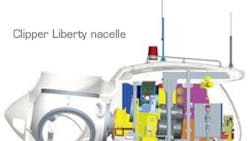Wind Turbines go Super-Sized
When it comes to wind turbine efficiency, bigger is generally better. Economies of scale let the cost-per-watt of generated power trend lower as wind turbines grow in size. But conventional technology has topped out at a rating of about 6 MW per turbine. The problem with making bigger units has partly been that the pieces-parts just become too heavy — transporting them on public roads becomes difficult. And their sheer size incurs other logistical difficulties.
Nevertheless, a few companies now think they have the technology to solve the weight issues. The result could be wind farms full of 10-MW turbines. One approach: Light and efficient generators made with room-temperature superconductors. That is the means now under investigation by American Superconductor Corp. The firm is working with the U.S. Dept. of Energy to make 10-MW class superconductor wind turbines economically attractive.
AMSC, Devens, Mass., and DOE's National Renewable Energy Laboratory are studying the economic impact and costs of AMSC's turbine model. The company's direct-drive wind generator systems use high-temperature superconductor wire instead of copper wire for the generator's rotor. That lets the resulting generator be much smaller, lighter and more efficient than conventional turbine design.
AMSC estimates the resulting 10-MW-class generator system would weigh approximately 120 metric tons. Existing generators with this power rating come in at about 300 metric tons. Direct drive generators of the sort AMSC plans also eliminate the need for massive gearboxes, the component with the highest maintenance costs in conventional wind turbines. AMSC says its lighter power trains should open up the opportunity for the development of wind farms in more areas.
The superconductor generators to be used for 10 MW-class turbines are based on technology the company has developed for ship propulsion motors and generators under contracts with the U.S. Navy. AMSC has successfully tested a 36.5-MW superconductor ship propulsion motor designed for the Navy.
It looks as though the first off-shore installation of 10 MW machines will be in U.K. waters. Turbine maker Clipper Windpower PLC has plans to deploy 7.5 and 10 MW versions of its turbines near New Castle in the U.K. Called the Britannia Project, the super-sized wind farm will build upon the architecture and technology of Clipper's Liberty 2.5 MW turbine. (See Machine Design Magazine, 6/5/08, “Inside an advanced wind turbine”) Clipper, in Carpinteria, Calif., will enlist the services and test facilities of the U.K.'s New and Renewable Energy Centre (NaREC) for the project.
According to Clipper Senior Vice President of Engineering Amir Mikhail, the Britannia turbines will be the biggest in the world with rotors spanning 150 m diameter. Plans are to put up 7.5-MW units on land, 10 MW off shore. The towers for these turbines will be about 195 m high, about as tall as a 50-story building.
Unlike what AMSC has in mind, the Britannia turbines will contain a gearbox. But, “The gearbox has considerable innovation that makes it compact and competitive with existing turbine technology,” says Mikhail. “It is different than what is going into our Liberty turbines, though it will have multiple generators, as does the Liberty, and will contain high-efficiency permanent magnet generators.”
Clipper is a bit cagey about the details of its Britannia turbine design because it has applied for patents on specific aspects of the machine which have yet to issue. It will say, however, that it has upgraded its technology for pitch control and has replaced batteries in the nacelle with capacitors. All in all, Mikhail says the company is shooting for an overall weight of about 500 tons, about that of a conventional 5 MW machine.
Clipper is also addressing the logistics of the large turbine parts involved by locating manufacturing operations on the U.K. coast, then floating blades and other components out to the turbine site by barge. For the 7.5-MW land-based turbines, Clipper expects to use a divided blade, one made in two halves which can be more easily transported to the turbine site for assembly. “The technique has been used on smaller blades but never on one 72 m in length,” says Mikhail.
The first Britannia prototype is scheduled to be completed in 2011. Mikhail says other EU countries are interested in the big turbines as a means of meeting an EU 20% renewable energy target by 2020. He also claims the giant-sized turbines could be practical for use in areas such as the Dakotas that are characterized by wide-open spaces and where assembly facilities could be set up close by.
